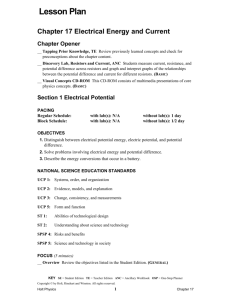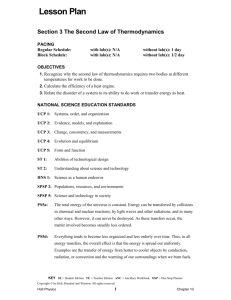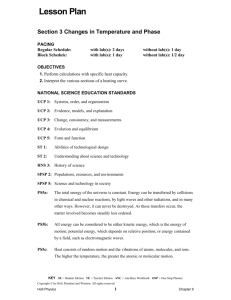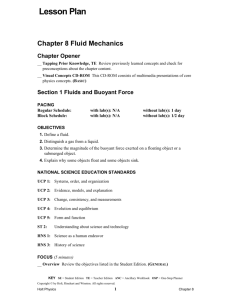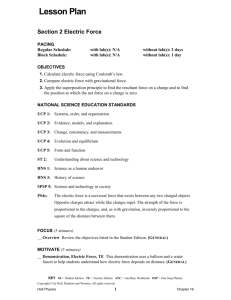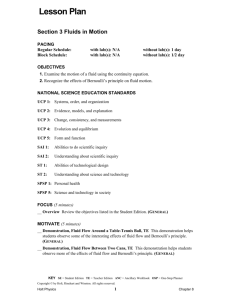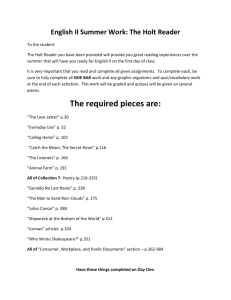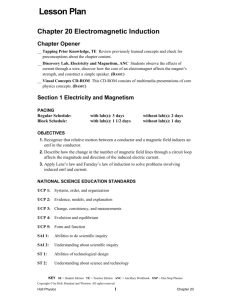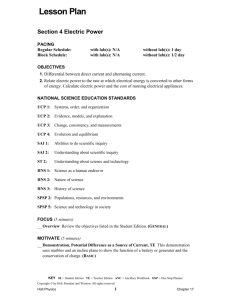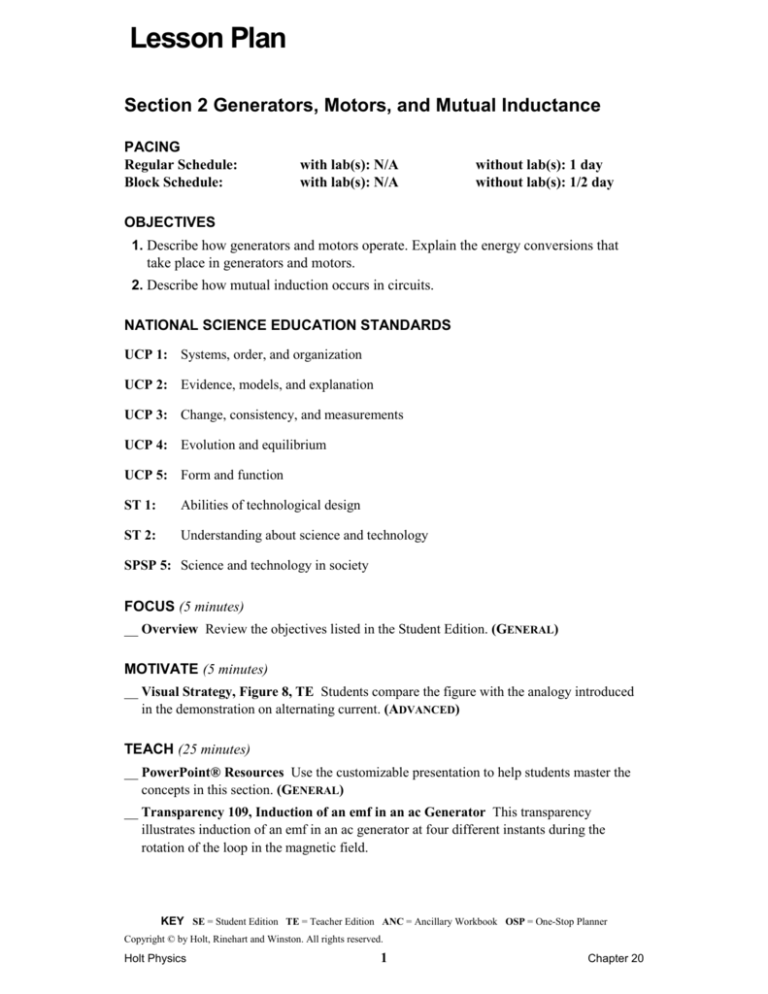
Lesson Plan
Section 2 Generators, Motors, and Mutual Inductance
PACING
Regular Schedule:
Block Schedule:
with lab(s): N/A
with lab(s): N/A
without lab(s): 1 day
without lab(s): 1/2 day
OBJECTIVES
1. Describe how generators and motors operate. Explain the energy conversions that
take place in generators and motors.
2. Describe how mutual induction occurs in circuits.
NATIONAL SCIENCE EDUCATION STANDARDS
UCP 1: Systems, order, and organization
UCP 2: Evidence, models, and explanation
UCP 3: Change, consistency, and measurements
UCP 4: Evolution and equilibrium
UCP 5: Form and function
ST 1:
Abilities of technological design
ST 2:
Understanding about science and technology
SPSP 5: Science and technology in society
FOCUS (5 minutes)
__ Overview Review the objectives listed in the Student Edition. (GENERAL)
MOTIVATE (5 minutes)
__ Visual Strategy, Figure 8, TE Students compare the figure with the analogy introduced
in the demonstration on alternating current. (ADVANCED)
TEACH (25 minutes)
__ PowerPoint® Resources Use the customizable presentation to help students master the
concepts in this section. (GENERAL)
__ Transparency 109, Induction of an emf in an ac Generator This transparency
illustrates induction of an emf in an ac generator at four different instants during the
rotation of the loop in the magnetic field.
KEY SE = Student Edition TE = Teacher Edition ANC = Ancillary Workbook OSP = One-Stop Planner
Copyright © by Holt, Rinehart and Winston. All rights reserved.
Holt Physics
1
Chapter 20
Lesson Plan
__ Transparency 110, Components of a DC Motor This transparency illustrates the basic
components of a dc motor.
__ Appendix J: Advanced Topics, Angular Kinematics, SE This feature allows students
to explore higher-level concepts related to the chapter. (ADVANCED)
__ Practice Problems, Induction in Generators, Online Students can visit go.hrw.com
and enter the keyword HF6EMIX to find this activity. Teacher resources can be found by
entering the keyword HF6EMIXT. (GENERAL)
__ Demonstration, Electric Motor, TE This demonstration uses a hand operated generator,
a capacitor, a resistor, and connecting wires to illustrate the similarity between generators
and motors. (GENERAL)
__ Demonstration, ac and dc, TE This demonstration uses a hand operated generator and
shows students the difference between alternating current and direct current. (GENERAL)
CLOSE (10 minutes)
__ Section Review, SE Students answer review questions, critical-thinking questions, and
interpreting-graphics questions that assess their understanding of the section objectives.
(GENERAL)
__ Study Guide, Generators, Motors, and Mutual Inductance, ANC Use this worksheet
to review the main concepts presented in the section. (GENERAL)
__ Section Quiz, ANC Use this quiz to assess students' understanding of the section.
(BASIC)
OTHER RESOURCE OPTIONS
__ Holt Online Learning Students can access interactive problem-solving help and active
visual concept development with the Holt Physics Online Edition available at
go.hrw.com.
__ SciLinks, Online Students can visit www.scilinks.org to find internet resources related
to the chapter content.
Topic: Alternating Current
SciLinks Code: HF60050
__ SciLinks, Online Students can visit www.scilinks.org to find internet resources related
to the chapter content.
Topic: Electrical Safety
SciLinks Code: HF60476
KEY SE = Student Edition TE = Teacher Edition ANC = Ancillary Workbook OSP = One-Stop Planner
Copyright © by Holt, Rinehart and Winston. All rights reserved.
Holt Physics
2
Chapter 20

